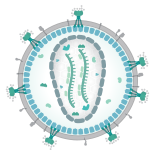Portal:Viruses/Selected virus/2
Human immunodeficiency virus (HIV) is a lentivirus, an RNA virus in the retrovirus family. Two types of HIV have been characterised: HIV-1 is the more virulent and is responsible for most infections worldwide; HIV-2 is mainly confined to West Africa. The genome consists of two copies of a single-stranded +RNA, which contains nine genes. The roughly spherical virus particle has a diameter of about 120 nm; it is enveloped and contains a conical capsid made of around 2,000 copies of the p24 protein. The envelope glycoprotein, a trimeric complex of gp120 and gp41, binds to CD4, the primary receptor on the host cell.
Transmission occurs by the transfer of bodily fluids including blood, semen, vaginal fluids and breast milk, in which the virus is present both as free virus particles and within infected immune cells. HIV infects key cells in the human immune system including CD4+ T helper cells, macrophages and dendritic cells. Infection leads to low levels of CD4+ T cells via several mechanisms, resulting in a progressive immunodeficiency disease known as AIDS.
